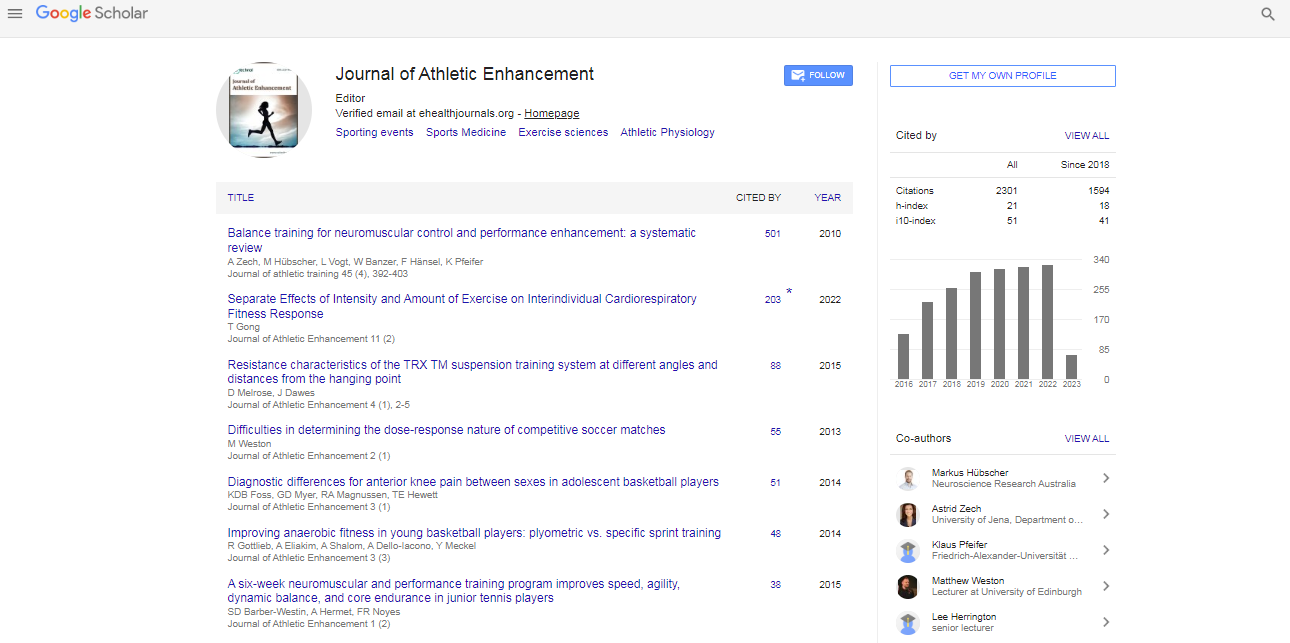Commentary, J Athl Enhanc Vol: 13 Issue: 5
Injury Management: Strategies for Recovery and Prevention
Miguel Ponce*
1Department of Physical Education and Sports, University of Extremadura, Caceres, Spain
*Corresponding Author: Miguel Ponce,
Department of Physical Education and
Sports, University of Extremadura, Caceres, Spain
E-mail: poncemiguel@unex.es
Received date: 26 August, 2024, Manuscript No. JAE-24-151412;
Editor assigned date: 28 August, 2024, PreQC No. JAE-24-151412 (PQ);
Reviewed date: 11 September, 2024, QC No. JAE-24-151412;
Revised date: 18 September, 2024, Manuscript No. JAE-24-151412 (R);
Published date: 25 September, 2024 DOI: 10.4172/2324-9080.1000145.
Citation: Poncek M, (2024) Injury Management: Strategies for Recovery and Prevention. J Athl Enhanc 13:5.
Description
Injury management is an important aspect of health care and athletic performance, encompassing the assessment, treatment and rehabilitation of injuries to ensure effective recovery and minimize the risk of re-injury.
Understanding injuries
Injuries can occur in various contexts, from sports and physical activities to daily life. They can be classified into two primary categories.
Acute injuries: These injuries occur suddenly and are typically the result of a specific incident, such as a fall, collision, or overexertion. Common acute injuries include sprains, fractures, strains and contusions.
Chronic injuries: Also known as overuse injuries, chronic injuries develop gradually over time, often due to repetitive motions or prolonged stress on specific body parts. Examples include tendonitis, bursitis and stress fractures.
Understanding the type of injury is essential for effective management and treatment.
Treatment modalities
The treatment of injuries varies based on their type and severity. Common treatment modalities include.
Medication: Over-the-counter pain relievers such as ibuprofen or acetaminophen can help alleviate pain and reduce inflammation. In more severe cases, prescription medications may be necessary.
Physical therapy: Physical therapy is often a key component of injury management. A physical therapist can design a personalized rehabilitation program that includes exercises to improve strength, flexibility and range of motion.
Surgery: In some cases, surgical intervention may be required, especially for severe injuries such as torn ligaments or fractures that do not heal properly. Surgical options can include repairing damaged tissues or reconstructing injured joints.
Alternative therapies: Techniques such as acupuncture, chiropractic care and massage therapy can complement traditional treatment approaches and may help in pain relief and recovery.
Rehabilitation strategies
Rehabilitation is an important phase in injury management, focusing on restoring function and preventing future injuries. Key strategies include:
Gradual return to activity: A structured approach to returning to physical activity is vital. This may involve starting with low-impact exercises and gradually increasing intensity as strength and mobility improve.
Strengthening exercises: Targeted exercises can help strengthen the muscles surrounding the injured area, providing better support and reducing the risk of re-injury.
Flexibility training: Stretching exercises improve flexibility and range of motion, which can be important for full recovery and performance.
Functional training: Incorporating sport-specific or activityspecific drills helps prepare the individual for a safe return to their usual activities or sports.
Monitoring progress: Regular assessments with healthcare providers or trainers can help track recovery progress and make necessary adjustments to the rehabilitation program.
Prevention strategies
Preventing injuries is an essential component of overall injury management. Key preventive measures include.
Warm-up and cool down: Engaging in a proper warm-up before physical activity prepares the body for exertion, while cooling down helps facilitate recovery.
Strength and conditioning: A well-rounded fitness program that includes strength training, cardiovascular conditioning and flexibility work can enhance overall physical strength.
Proper technique: Learning and maintaining proper technique in sports and physical activities can help reduce the risk of injuries. Coaches and trainers can provide valuable guidance in this area.
Injury management is a multifaceted process that requires a comprehensive approach to assessment, treatment, rehabilitation and prevention. By understanding the types of injuries and implementing effective management strategies, individuals can enhance their recovery, reduce the risk of re-injury and maintain a healthy, active lifestyle. Whether in sports or everyday activities, prioritizing injury management is essential for long-term health and well-being.
 Spanish
Spanish  Chinese
Chinese  Russian
Russian  German
German  French
French  Japanese
Japanese  Portuguese
Portuguese  Hindi
Hindi 
